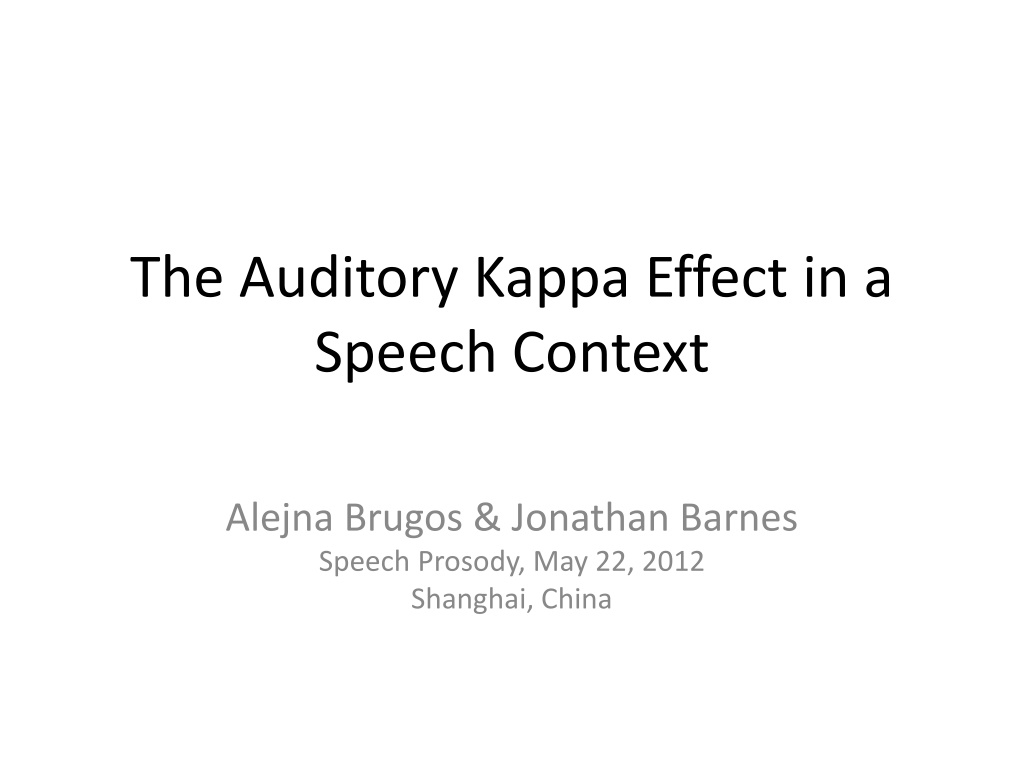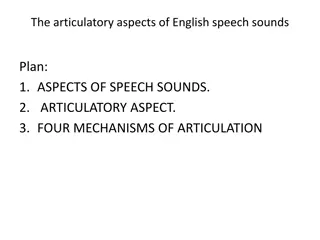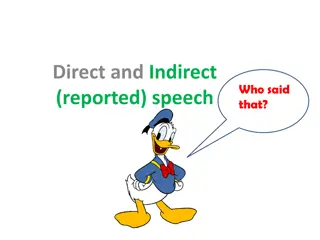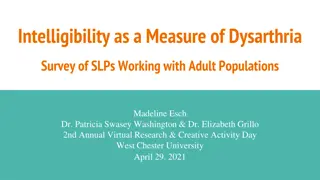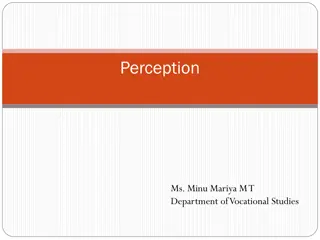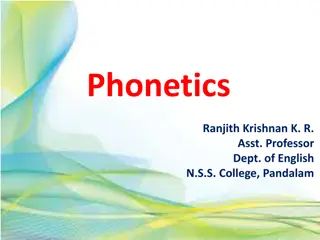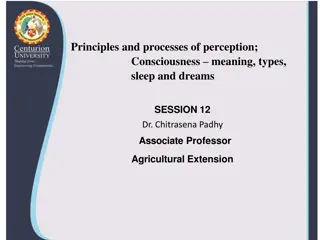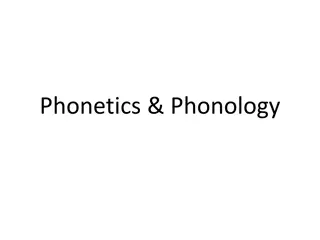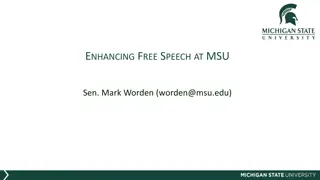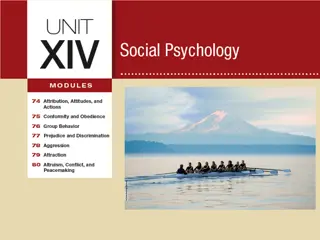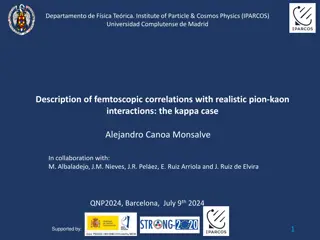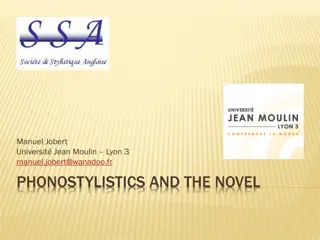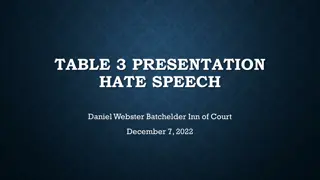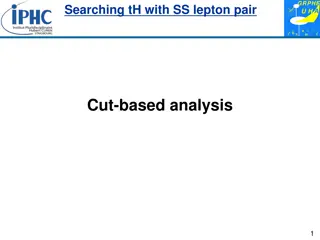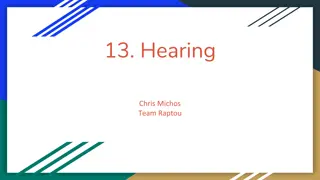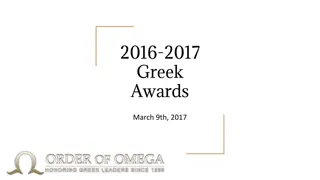Exploring the Auditory Kappa Effect in Speech Perception
The auditory kappa effect, originally observed in non-speech contexts, is investigated in speech perception. This study explores how pitch and timing interactions influence the perception of vowel duration and silent intervals in spoken words. Using the kappa cell paradigm, experiments examine the relative frequency of tones and pitch distances in short spoken word sequences to understand if the auditory kappa effect is present in speech perception.
Download Presentation

Please find below an Image/Link to download the presentation.
The content on the website is provided AS IS for your information and personal use only. It may not be sold, licensed, or shared on other websites without obtaining consent from the author. Download presentation by click this link. If you encounter any issues during the download, it is possible that the publisher has removed the file from their server.
E N D
Presentation Transcript
The Auditory Kappa Effect in a Speech Context Alejna Brugos & Jonathan Barnes Speech Prosody, May 22, 2012 Shanghai, China
The perception of time Measured time Perceived time
The interaction of pitch and timing Dynamic F0 in speech can lead to longer perceived vowel duration (Yu, 2010; Cumming, 2011) Non-speech research showing that pitch manipulations can alter perception of timing (Crowder & Neath, 1995 ; Henry, 2011; inter alia) The auditory kappa effect (Cohen et al., 1954; Henry & McAuley, 2009; inter alia)
The auditory kappa effect In a sequence of level tones, the relative frequency of the tones can distort the perception of silent intervals between them. The two silent intervals t1 and t2 are of the same objective duration, but t2 is perceived as longer than t1 The mind expects that a greater pitch distance will take longer to traverse than a shorter distance, and adjusts perception accordingly.
Does the auditory kappa effect obtain in speech? Conducted an experiment closely modelled after non-speech kappa studies Sequences of short spoken words in place of short tones Used concatenated AXB sequences A, X, and B were all resynthesized versions of the spoken word one Single-word full IP (H* L-L%) To be speech-like (vs. sounding like singing) Symmetrical rise-fall From same 302 ms. naturally spoken base recording
The kappa cell paradigm Following Shigeno, 1986; MacKenzie, 2007 In AXB sequences of sound events, A and B are fixed in pitch space, and in time relative to each other A pitch X Only the intermediate event X changes, in both time and pitch space B time
The kappa cell paradigm Following Shigeno, 1986; MacKenzie, 2007 In AXB sequences of sound events, A and B are fixed in pitch space, and in time relative to each other A X pitch Only the intermediate event X changes, in both time and pitch space B time
The kappa cell paradigm Following Shigeno, 1986; MacKenzie, 2007 In AXB sequences of sound events, A and B are fixed in pitch space, and in time relative to each other A X pitch Only the intermediate event X changes, in both time and pitch space B time
The kappa cell paradigm Following Shigeno, 1986; MacKenzie, 2007 In AXB sequences of sound events, A and B are fixed in pitch space, and in time relative to each other A X pitch Only the intermediate event X changes, in both time and pitch space B time
Stimuli: timing & pitch steps The whole rise-fall contour was shifted in 1 st. steps Highest contour 8 st above base Base contour had range of 150-200 hz 7 intermediate steps for X AXB sequences concatenated with 2 intervening silences, t1 and t2 t1 + t2 always equal to 1000 ms. 10 time steps for each between 410 and 590 ms.
Stimuli: pitch change direction 2 directions: descending & ascending A B X X pitch pitch B A time time
A sample stimulus A X B
A sample stimulus A X B 6 semitones 2 semitones
A sample stimulus A X B 6 semitones 2 semitones t1=490 ms. t2=510 ms.
A sample stimulus A X B 6 semitones 2 semitones t1=490 ms. t2=510 ms.
Task Task: subjects asked to indicate whether the middle one was closer in timeto the first or last one Explicitly instructed to try to ignore pitch 31 subjects 16 for the ascending condition, 15 for the descending All heard 4 repetitions of 70 stimuli (7 pitch steps x 10 time steps)
Results X sounds closer to B
Results X sounds closer to A
Results X is closer to A
Results X is closer to B
Analysis: The kappa effect obtains Subject responses were based primarily on interval duration, but modulated by relative pitch. As with the kappa effect in non-speech studies, perception of pause duration was distorted by pitch differences Closer in pitch sounded closer in time. Many possible directions to go Exploring the magnitude, robustness and generalizability of the effect Order effects Effect of pitch change velocity, length of material Cross linguistic studies How might these same manipulations affect linguistic judgments?
Follow-up experiment: Prosodic Grouping Using the same materials, this time we asked subjects not about the timing of the words, but their grouping Did the sequences of numbers sound like (one one) (one)or (one) (one one) ? Identical stimuli to the timing experiment 14 subjects, descending order only
Results: grouping perception Proportion responses: X grouped with B
Results: grouping perception Proportion responses: X grouped with B
Timing perception Grouping perception
Analysis: grouping perception Surprisingly, timing affected judgments of grouping fairly little Items closer in pitch were perceived as grouped together The results looking strikingly different from those of the time judgment task. If the kappa effect is active in speech perception, this in itself is not sufficient to explain the results The effect of pitch looks strikingly categorical Only the middle (ambiguous) pitch steps showed a strong effect of time It looks like pitch distance may have some sort of status of its own for prosodic grouping
Pitch, timing & grouping F0 cues are recognized as important to grouping Phrase accents and boundary tones (Beckman & Ayers Elam,1997) Phrase-initial reset (Jun, 2006; Lin & Fon, 2011) Pitch accent scaling (Ladd, 1988; F ry & Truckenbrodt, 2005) Discourse segmentation (Oliveira & Cunha, 2004 ; Hirschberg, 2004; Carlson et al. 2005) F0 cues are sometimes found to be secondary to timing ones (Holzgrefe et al 2011; Hansson, 2003) F0 omitted from some studies Quantification of boundary strength based only on objective duration may miss powerful cues from F0.
Exploring pitch/time interaction Investigations of pitch/time interaction in perception may: Shed light on mismatches of duration and phrasing perception Jumps in pitch across pauses may signal stronger boundaries Steady pitch may signal weaker boundary than duration indicates Contribute to our understanding of grouping across phrases Compatible with boundary strength being inherently relative and grouping being recursive (Wagner & Crivellaro, 2010; Kentner & F ry, forthcoming) We may consider pitch distance between phrases (with timing distance) in the light of principles of grouping: Proximity & Anti-proximity (Kentner & Fery, forthcoming) Gestalt principles of grouping (Lerdahl & Jackendoff, 1983; Wertheimer, 1938) Auditory streaming, auditory scene analysis (Bregman, 1990)
Points of departure Listeners are sensitive to F0, even when judging time Perceived time is subject to F0-based distortions Pitch and timing may be in a cue trading relationship (Beach, 1991) Future directions: Segmental length, boundary-related lengthening Interaction of pitch jumps with F0 contour/boundary tone Look for similar effects in other languages Influence of temporal factors on perceived pitch (tau effect) Look at production data, spontaneous speech We should work towards a quantitative measure of boundary strength that incorporates aspects of both pitch and duration
Timing perception Grouping perception There is much to be investigated in the interaction of timing and pitch in speech perception.
Thank you! Acknowledgments: This work was supported by NSF grant #1023853
Timing perception Grouping perception There is much to be investigated in the interaction of timing and pitch in speech perception.
References Beach, C. (1991). The interpretation of prosodic patterns at points of syntactic structure ambiguity: Evidence for cue trading relations. Journal of Memory and Language, 30(6): 644 663. Beckman, M., & Ayers Elam, G. (1997). Guidelines for ToBI Labelling. (v. 3). Carlson, R., Hirschberg, J., & Swerts, M. (2005). Cues to upcoming Swedish prosodic boundaries: Subjective judgment studies and acoustic correlates. Speech Communication, 46(3-4), 326 333. Cohen, J., Hansel, C. & Sylvester, J. (1954). Interdependence of temporal and auditory judgments. Nature, 174: 642 644. Crowder, R. & Neath, I. (1995). The influence of pitch on time perception in short melodies. Music Perception, 12(4): 379 386. Cumming, R. (2001). The effect of dynamic fundamental frequency on the perception of duration. Journal of Phonetics, 39(3): 375 387. F ry, C. & Truckenbrodt, H. (2005). Sisterhood and tonal scaling. Studia Linguistica, 59(3): 223-243. Hansson, P., 2003. Prosodic phrasing in spontaneous Swedish. PhD thesis. Lund University, Sweden.
Henry, M. & McAuley, J. (2009). Evaluation of an imputed pitch velocity model of the auditory kappa effect. Journal of Experimental Psychology: HPP, 35(2): 551 564. Henry, M. (2011). A Test of an Auditory Motion Hypothesis for Continous and Discrete Sounds Moving in Pitch Space. PhD. Dissertation. Bowling Green State University. Hirschberg, J. (2004). Pragmatics and intonation. The handbook of pragmatics, 515 537. Holzgrefe, J., Schr der, C., H hle, B. & Wartenburger, I. (2011). Neurophysiological investigations on the processing of prosodic boundary cues. ETAP 2, Montreal. Jun, S.-A. (2006). Intonational phonology of Seoul Korean revisited. In T. Vance & K. Jones (Eds.), Japanese/Korean Linguistics 14 (p. 15-26). Stanford: CSLI. Kentner, G. & F ry, C. (forthcoming). A new approach of prosodic grouping. The Linguistic Review. Ladd, D. (1988). Declination reset and the hierarchical organization of utterances.JASA, 84: 530-544. Lerdahl, F., Jackendoff, R., 1983. A generative theory of tonal music. The MIT Press.
Lin, H. & Fon, J. (2011). The role of pitch reset in perception at discourse boundaries. ICPhS XVII, Hong Kong. MacKenzie, N. (2007). The kappa effect in pitch/time context. PhD. Dissertation, Ohio State University. Oliveira, M., Jr, & Cunha, D. (2004). Prosody As Marker of Direct Reported Speech Boundary. Speech Prosody. Shigeno, S. (1986). The auditory tau and kappa effects for speech and nonspeech stimuli. Perception & Psychophysics, 40(1): 9 19. Wagner, M. & Crivellaro, (2010). Relative Prosodic Boundary Strength and Prior Bias in Disambiguation. SpPros, Chicago. Wertheimer, M. (1938). Laws of organization in perceptual forms. In: Ellis, W. (Ed.), A source book of Gestalt psychology. London: Routledge & Kegan Paul, pp. 71 88. Wightman, C., Shattuck-Hufnagel, S., Ostendorf, M. & Price, P. (1992). Segmental durations in the vicinity of prosodic phrase boundaries. JASA, 91: 1707 1717. Yu, A. (2010). Tonal effects on perceived vowel duration. In C. Fougeron, B. K hnert, M. D Imperio & N. Vall e (Eds.), Papers in Lab. Phon. (10). Berlin: M. de Gruyter.
